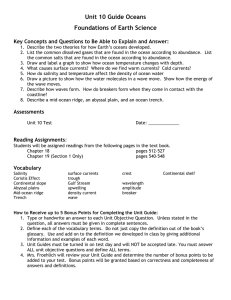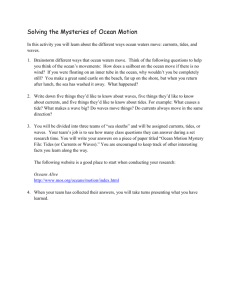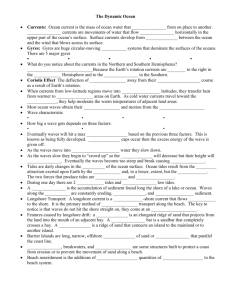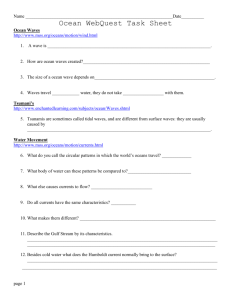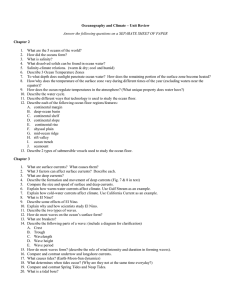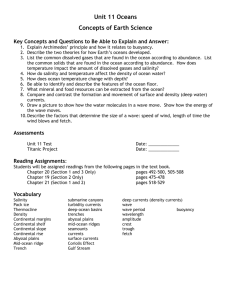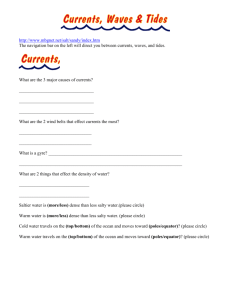u Tide Cycle - Plain Local Schools
advertisement
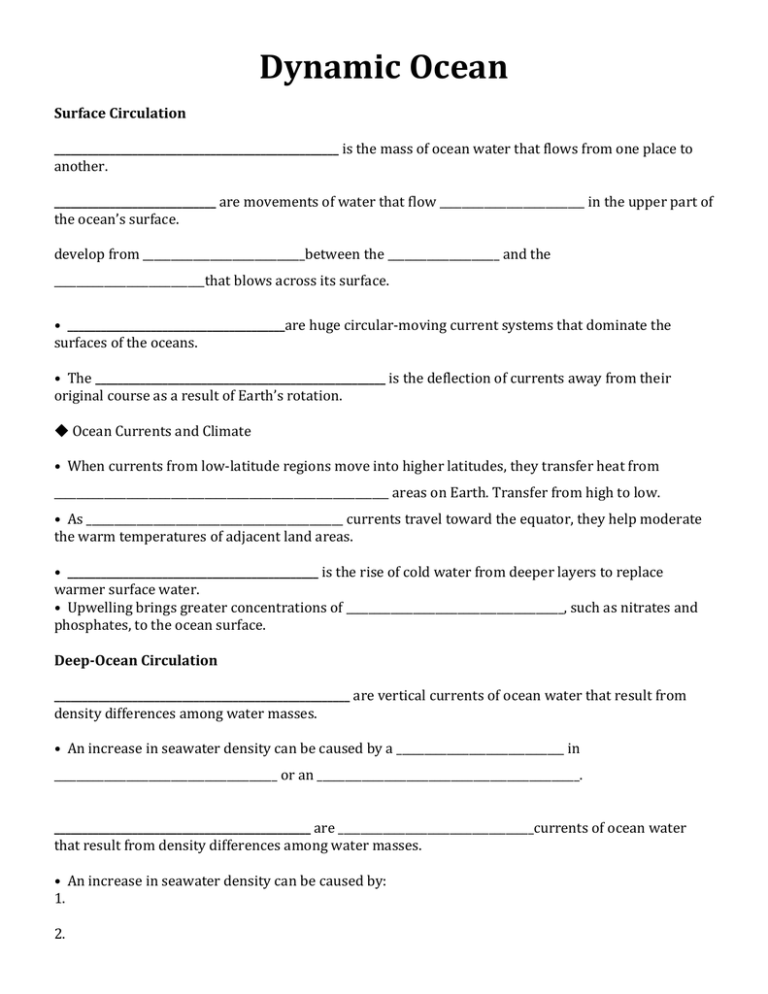
Dynamic Ocean Surface Circulation ___________________________________________________ is the mass of ocean water that flows from one place to another. _____________________________ are movements of water that flow __________________________ in the upper part of the ocean’s surface. develop from _____________________________between the ____________________ and the ___________________________that blows across its surface. • _______________________________________are huge circular-moving current systems that dominate the surfaces of the oceans. • The ____________________________________________________ is the deflection of currents away from their original course as a result of Earth’s rotation. Ocean Currents and Climate • When currents from low-latitude regions move into higher latitudes, they transfer heat from ____________________________________________________________ areas on Earth. Transfer from high to low. • As ______________________________________________ currents travel toward the equator, they help moderate the warm temperatures of adjacent land areas. • _____________________________________________ is the rise of cold water from deeper layers to replace warmer surface water. • Upwelling brings greater concentrations of _______________________________________, such as nitrates and phosphates, to the ocean surface. Deep-Ocean Circulation _____________________________________________________ are vertical currents of ocean water that result from density differences among water masses. • An increase in seawater density can be caused by a ______________________________ in ________________________________________ or an _______________________________________________. ______________________________________________ are ___________________________________currents of ocean water that result from density differences among water masses. • An increase in seawater density can be caused by: 1. 2. Composition of Seawater ____________________________________________________ Most water involved in deep-ocean currents begins in high latitudes at the surface. ___________________________________________________Density currents can also result from increased salinity of ocean water due to evaporation. Deep-Ocean Circulation In a simplified model, ocean circulation is similar to a conveyor belt that travels from the _____________________________________________, through the __________________________and _____________________________________Oceans, and back again. Waves • Most ocean waves obtain their energy and motion from the _________________________. • The wave ______________________________ is the _____________________ distance between the ______________________and __________________________________. • The _________________________________________is the horizontal distance between two _____________________________________________________________________________________________. • The ____________________________________________ is the time it takes one full wave—one wavelength—to pass a fixed position. • ____________________________________________is the distance that the wind has traveled across open water. • The height, length, and period that are eventually achieved by a wave depend on three factors: (1) (2) (3) Draw and Label a Wave Breaking Waves • Changes occur as a wave moves onto shore. • As the waves _____________________________________wave speed _____________________. The decrease in wave speed results in a __________________________in wavelength and an _____________________________ in wave __________________________________. _____________________are daily changes in the elevation of the ocean surface. Ocean tides result from the _______________________________________________ exerted upon Earth by the ________________________ and, to a lesser extent, by the ________________________. Tide Cycle • ___________________________________ is the difference in height between successive high and low tides. • _______________________________ are tides that have the _____________________________tidal range due to the ______________________________________________ of the _________________________ ___________________________________ _____________________________________ system. • ____________________________________tides are tides that have the lowest tidal range, occurring near the times of the first-quarter and third-quarter phases of the moon. Forces Acting on the Shoreline A beach is the __________________________________________ found along the shore of a lake or ocean Waves along the shoreline are constantly ___________________________________ _______________________________ or__________________________ sediment. Many types of shoreline features can result from this activity. Wave Impact • The impact of large, high-energy waves against the shore can be awesome in its violence. Each breaking wave may hurl thousands of tons of water against the land, sometimes causing the ground to tremble. • ___________________________________is the sawing and grinding action of rock fragments in the water. • Abrasion is probably more intense in the surf zone than in any other environment. • A _____________________________________ _________________________________ is a near-shore current that flows parallel to the shore. • ______________________________________allows longshore currents to easily move fine suspended sand and to roll larger sand and gravel particles along the bottom. • ____________________________________________________ result from the cutting action of the surf against the base of coastal land. A flat, bench-like, wave-cut platform forms in front of the wave-cut cliff. Sea Arches and Sea Stacks • When __________________________________ on opposite sides of a headland ________________________, a sea arch results. Eventually, the arch falls in, leaving an isolated remnant, or _______________________________ on the wave-cut platform. Spits, Bars, and Tombolos • Where longshore currents and other surf zone currents are active, several features related to the movement of sediment along the shore may develop. - A _________________________________ is an elongated ridge of sand that projects from the land into the mouth of an adjacent bay. - A _____________________________________bar is a sandbar that completely crosses a bay. - A ___________________________________________ is a ridge of sand that connects an island to the mainland or to another island. Depositional Features • Barrier islands are narrow sandbars parallel to, but separate from, the coast at distances from 3 to 30 kilometers offshore. Stabilizing the Shore Protective Structures • Groins, _____________________________________, and __________________________ are some structures built to protect a coast from erosion or to prevent the movement of sand along a beach. • Beach nourishment is the addition of large quantities of sand to the beach system.
